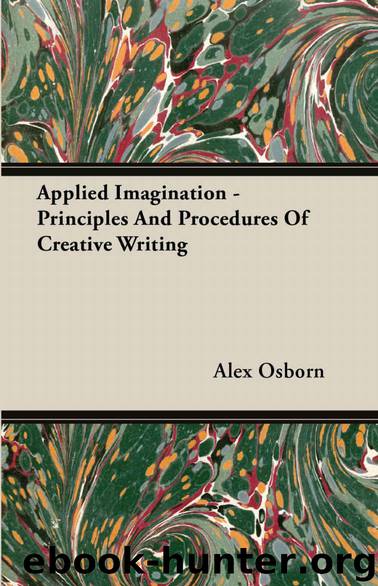Applied Imagination - Principles and Procedures of Creative Writing by Alex Osborn

Author:Alex Osborn
Language: eng
Format: mobi
Publisher: Read Books Ltd.
Published: 2013-04-15T14:00:00+00:00
2. The inexplicability of illumination
Modern science recognizes the productivity of illumination. Doctor Walter B. Cannon of Harvard, after 40 years in physiological research, wrote in his book entitled The Role of Hunches: “From the years of my youth, the unearned assistance of sudden and unpredicted insight has been common.” His investigation of the creative habits of 232 high-standing chemists revealed that over a third of these scientists gave credit to hunches.
Many scientists of the past likewise stressed illumination. Said Darwin in his autobiography, “I can remember the very spot in the road, whilst in my carriage, when to my joy the solution occurred to me.” Hamilton, describing his discovery of equations, reported that his basic solution came to him as he “was walking with Lady Hamilton to Dublin, and came up to Brougham Bridge.” But Darwin and Hamilton had put in years of deliberate thinking to reach those points of illumination.
In literature, the same phenomenon has been marveled at by Goethe, Coleridge and countless others, and often referred to figuratively. Stevenson spoke of his “Brownies” as helpers who worked for him while he slept. Barrie gave much credit to “McConnachie”—whom he described as “the unruly half of me, the writing half.” Milton dubbed as “droughts” his periods of illumination. He actually courted these spells by just brooding over a theme and deliberately writing nothing. Sometimes in the night he would awaken his daughters in order to dictate his poetry to them.
Modern authors have similarly attested. “A story must simmer in its own juice for months or even years before it is ready to serve,” wrote Edna Ferber. A newer novelist, Constance Robertson, told me this: “I have found that it pays to hold a plot in suspension, and not to worry it or force it. At the right point, I go into a long lull. Then, I tackle my typewriter and write whatever comes. My story then seems to reel itself off in a most extraordinary way.”
Illumination has been explained as “intellectual rhythm”; but that seems more poetic than expository. A clearer psychological explanation was put forth by Doctor Elliott Dunlap Smith: “If the knowledge of the inventor and the clues which will bring the invention into being have been brought nearly into position to provide the inventive insight, his inner tension will be strong. . . . As he nears his goal he will become increasingly excited. . . . It is no wonder that the sudden release of such inner tension is often described as a ‘flash.’ ”
Unconscious effort in the form of inner tension appears to be a most likely theory. But there may be other ways to explain illumination, and one of these has to do with motivation. Creative thinking thrives on enthusiasm, and this tends to lag when we force our minds beyond a certain point. By letting up a while, we tend to regenerate our emotional urge.
Another explanation is that our power of association often works best when running freely on its own. During
Download
This site does not store any files on its server. We only index and link to content provided by other sites. Please contact the content providers to delete copyright contents if any and email us, we'll remove relevant links or contents immediately.
Rewire Your Anxious Brain by Catherine M. Pittman(18504)
Talking to Strangers by Malcolm Gladwell(13157)
The Art of Thinking Clearly by Rolf Dobelli(10162)
Mindhunter: Inside the FBI's Elite Serial Crime Unit by John E. Douglas & Mark Olshaker(9126)
Becoming Supernatural by Dr. Joe Dispenza(8059)
Change Your Questions, Change Your Life by Marilee Adams(7584)
The Road Less Traveled by M. Scott Peck(7494)
Nudge - Improving Decisions about Health, Wealth, and Happiness by Thaler Sunstein(7490)
The Lost Art of Listening by Michael P. Nichols(7375)
Mastermind: How to Think Like Sherlock Holmes by Maria Konnikova(7185)
Enlightenment Now: The Case for Reason, Science, Humanism, and Progress by Steven Pinker(7110)
Win Bigly by Scott Adams(7053)
The Way of Zen by Alan W. Watts(6470)
Daring Greatly by Brene Brown(6388)
Big Magic: Creative Living Beyond Fear by Elizabeth Gilbert(5570)
Grit by Angela Duckworth(5465)
Ego Is the Enemy by Ryan Holiday(5256)
Men In Love by Nancy Friday(5131)
Altered Sensations by David Pantalony(5021)
